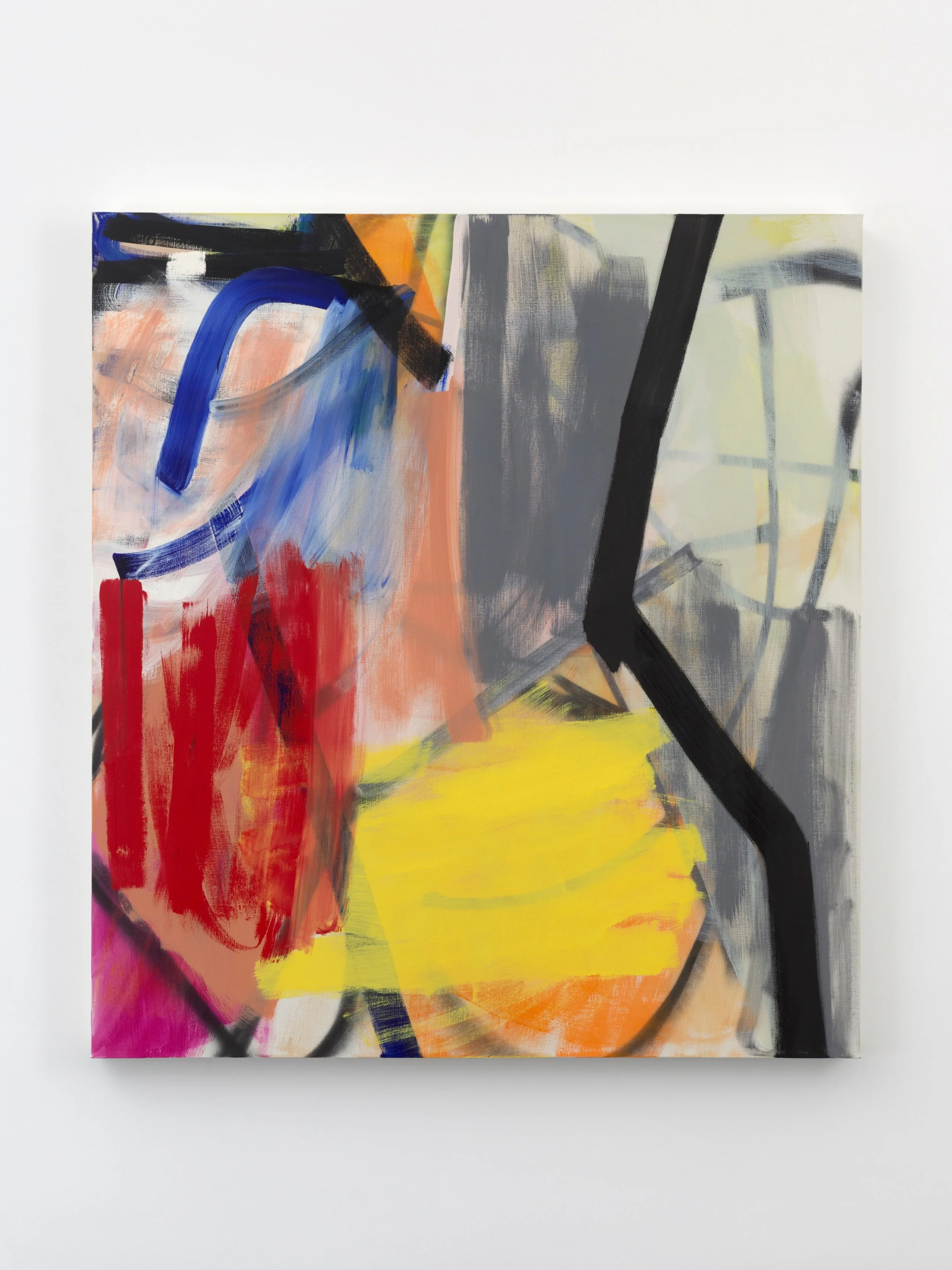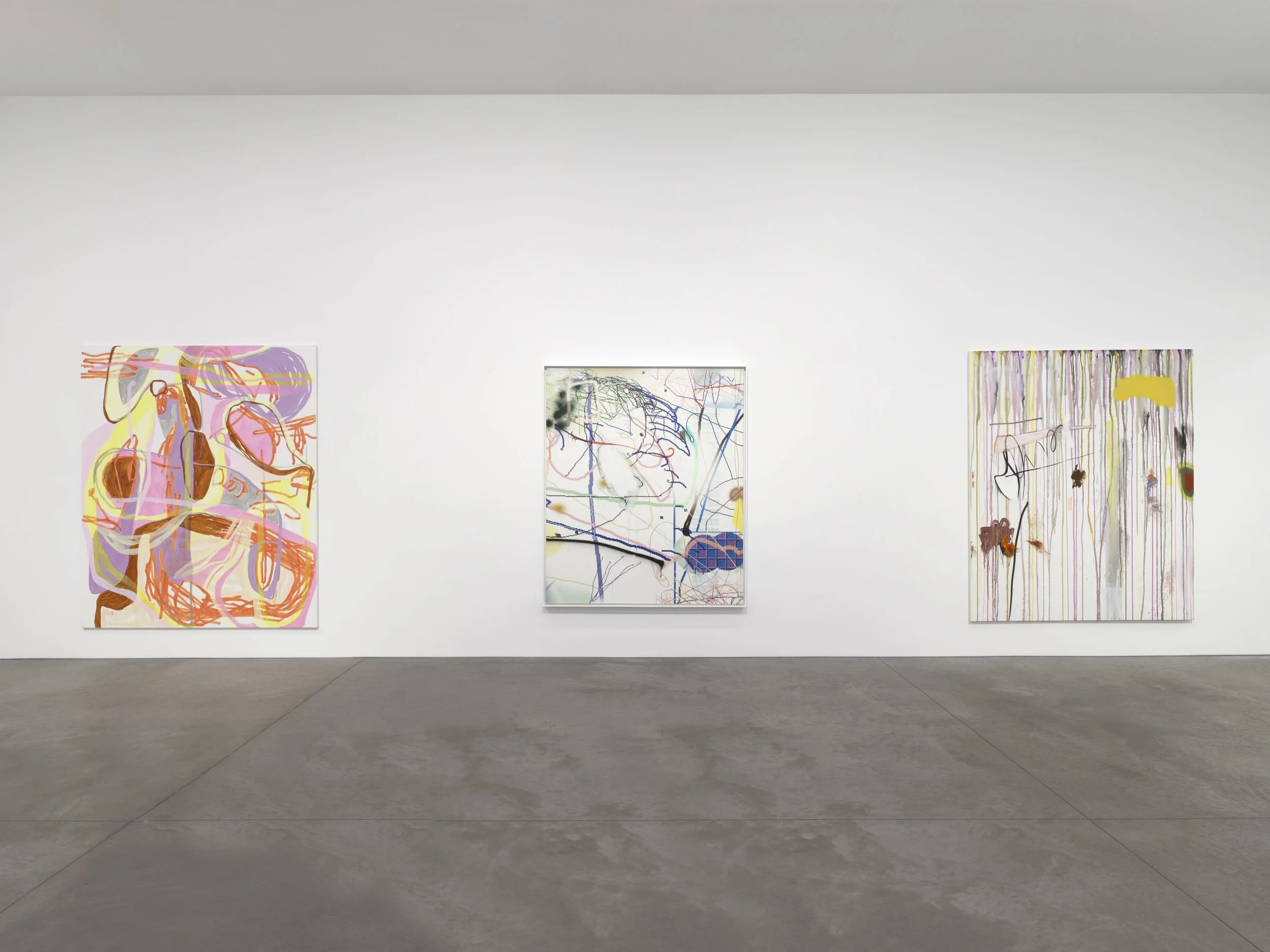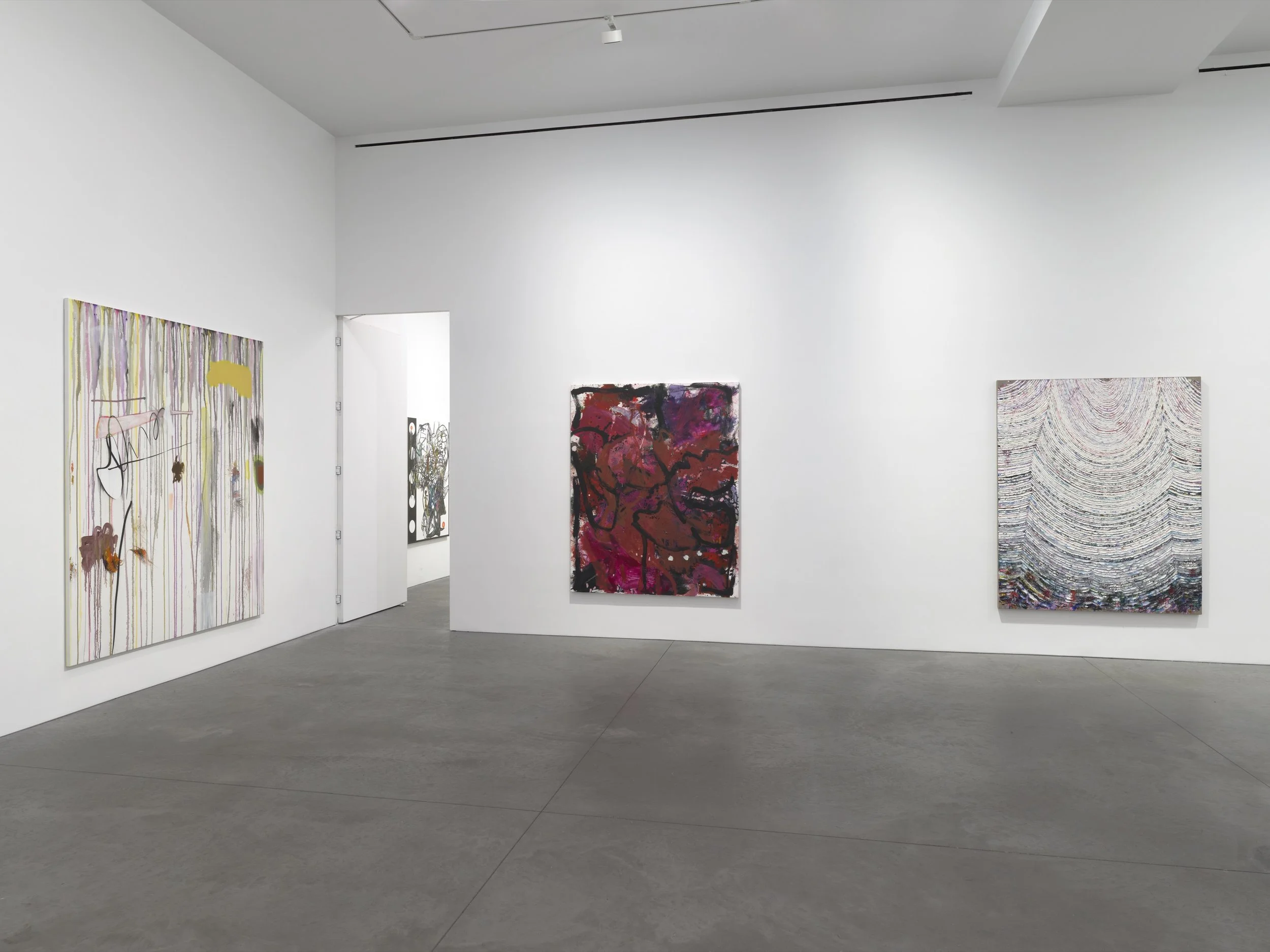aligned
Nino Mier Gallery
February 12 through March 22, 2025
Exhibition Review by Raphy Sarkissian
Installation view at Nino Mier Gallery on Crosby Street, New York.
Photo by Elisabeth Bernstein. Courtesy of the artists and Nino Mier Gallery.
Through works by twenty artists, this astutely curated exhibition marks the tenth anniversary of Nino Mier Gallery. Seeking to destabilize the rigidity of meaning within such a binary opposition as aligned versus unaligned, along with linearity versus painterliness, this project of Nino Mier calls forth fluidity of meaning and an expansion of the constrictions of structuralist logic. With its antithetical title that at once asserts and negates the notion of alignment, aligned awakens memories of On Line: Drawing Through the Twentieth Century that superbly interrogated the history of drawing, linearity, coloration, gesture, and mark-making some fifteen years ago at the Museum of Modern Art in New York.
Whereas this compelling show registers as an arena of quintessential experimentations of lines and colors over the painting’s inherently flat surface, Anna Fasshauer’s suavely waggish three-dimensional object Boney (2024) portrays sculpture itself as a gestural medium and registers as a method of drawing its titular theme in space. Though the sculptural subject of Boney imparts the humor of Claes Oldenburg, it is the formalist language of Franz West that Fasshauer has so brilliantly rewritten through the linear pliability of aluminum and the grace of bone-white lacquer.
Installation view at Nino Mier Gallery on Crosby Street, New York. Photo by Elisabeth Bernstein. Courtesy of the artists and Nino Mier Gallery.
And whereas the improvisatory paintings by seventeen artists register as primarily nonfigurative conduits of expression and ideas, Alexandria Tarver’s spellbinding painting nights, 83, TS 1 (2025), with its hypnotic depiction of cherry blossoms, comes across as an enigmatic juncture of abstraction and figuration. As if a modernist nod to still lifes from the Flemish and Dutch golden age, Tarver reconciles the monochromatic abstraction of the pictorial surface in indigo with the vibrance and sensuous beauty of illusive blooms in shades of coral pink. Conversely, mounted to the right of this figurative painting, Tarver’s highly abstract waiting, 10 (2025) aligns itself with the erratic scribbles of Cy Twombly, floating in pink over an ultramarine ground. Viewed jointly, these two paintings hint at abstraction and figuration as reciprocal underpinnings within a phenomenological context of our visual perception of the world.
A significant degree of figuration also prevails within Ana Villagomez’s emblematic La Máquina de Sueños (Dream Machine) (2025), where uncanny silhouettes of the human figure are entangled within a formless curvilinear mesh set against a flat white ground. As if a tribute to Max Ernst’s surrealist vocabulary, this enigmatic painting of Villagomez drives the onlooker toward the realm of dreams and the unconscious, where reality and imagination register as fragmentary entanglements of painterly figures with linear contours.
The semantic dilemma inherent within the title, simultaneously aligned and unaligned, also lends itself as a discursive springboard that invites the visitor to probe the extent to which the formalist language of a given painting may conjure up modernist antecedents and diverge from them. Though Sue Williams’s large-scale painting Activated Glowstick (2000) recalls the serpentine style of Willem de Kooning’s late period, the work ultimately aligns itself as an antidote to the modernist notion of pure autonomy. Through feminist undertones and within the broader context of the artist’s output that addresses gender and sexuality, the sinewy ropes and bleeding drips of Williams realign the modernist canon of the purity and self-containment of abstract painting.
Installation view at Nino Mier Gallery on Crosby Street, New York. Photo by Elisabeth Bernstein. Courtesy of the artists and Nino Mier Gallery.
The contention of line as color versus color as line is distinctively encapsulated within Frederic Anderson’s jewellike Antigone, Swans, Dandelion Kid (2020), where hazy linear traces in vibrant colors carry with them a sense of sfumato, as if to reanimate the debate of line-versus-color through sprayed paint. This formalist strategy of Anderson collapses the distinctions of such oppositions as calligraphy/graffiti, design/trace, linearity/painterliness, thus signaling at the confines of linguistic alignments.
Oil paint functions as frenetic frosting upon André Butzer’s iconoclastic, Klee-like composition that aligns itself toward a sense of forcefulness and raw graffiti as imperative mechanisms of the originative impulse. Butzer’s geometric mark-making and erasure evoke Nietzsche’s concept of inventiveness as a dichotomy between rationality and Dionysian excess. Through chaotic gestures upon orderly linear traces, Untitled (2009) imparts ceaseless hesitancy as an inventive activity.
Liliane Tomasko, a dream of: BEING CAUGHT WITH NO FEELING, 2017. Oil, acrylic and acrylic spray on linen, 68 by 62 inches. Photo by Elisabeth Bernstein. Courtesy of the artist and Nino Mier Gallery.
The diaphanous gestures of Liliane Tomasko transport the beholder into a luminous space where colors have become transubstantiated into misty light. This atmospheric landscape of Tomasko appears as a testament to vision’s own configuration as a simultaneity of exterior and interior spaces, where the cerebrum’s occipital lobe receives and processes raw image data from the retinas. “I do not see [space] according to its exterior envelope; I live in it from the inside; I am immersed in it. After all, the world is around me, not in front of me,” explains Maurice Merleau-Ponty.(1) Titled a dream of: BEING CAUGHT WITH NO FEELING (2017), Tomasko’s unfathomable space also signals at the inseparability of consciousness and the unconscious during the burst of creative activity. Through the gesture’s spellbinding translucence, Tomasko has undertaken a fresh impetus to painterly abstraction: at once extending the trajectory of AbEx gesturalism and aligning elusive brushmarks with luminosity and the visceral conditions of sight.
Joanne Greenbaum, Untitled, 2024. Acrylic, flashe, oil, marker, and ink on canvas, 70 by 65 inches. Photo by Elisabeth Bernstein. Courtesy of the artist and Nino Mier Gallery.
Joanne Greenbaum has entirely realigned Cy Twombly’s esoteric scribbles with the compositional sensibility of Frank Stella’s flamboyantly constructed three-dimensional paintings and silkscreens of the mid-seventies and onward. (Consider, for example, Stella’s 1997 screenprint Coxuria of the Whitney Museum.) Through acrylic, flashe, oil, marker and ink, Greenbaum has executed a highly intricate painting that shifts the definition of scribbling from the domain of the manual to that of the bodily, from the motility of the hand to that of the corpus. Having overlapped the methods of drawing and painting, Greenbaum’s Untitled (2024) ingeniously brings forth abstract scribbles upon a large-scale painting as magnified mirages of the hand-drawn, prompting the onlooker to reassess the concept of abstraction.
Installation view at Nino Mier Gallery on Crosby Street, New York. Photo by Elisabeth Bernstein. Courtesy of the artists and Nino Mier Gallery.
Brisk, bouncing and dance-like movements of hand and body have articulated the partly filled white surface of the large-scale painting PERLASYNTHIC L7 (2022) of Jana Schröder. As Isabella Pigoni Miller has eloquently noted, “Like footprints on a snowy path, each mark on the canvas registers the artist’s body at work. Schröder’s painting possesses a kind of performative corporeality, closing the distance between the act of painting and the act of seeing and creating a palpable intimacy between the viewer and the artist.”(2) These words can also be seen to unmistakably mirror all the paintings in this exhibition, where the painterly and fluid manner of mark-making registers as a shared catalyst among the artists.
Recalling Robert Rauschenberg’s nifty use of silkscreen and oil on canvas, Albert Oehlen’s Das Gewicht der Ladung (2022) is an outstanding meeting place of a series of rational and irrational oppositions: sheer bacchanalia and an aura of asceticism; the doodling of serpentine lines and the systematic grid; pixelated lines and their analog replication. The computer-generated image of Oehlen has given way to a silkscreen backdrop upon which the image has been manually shaped as well, resulting in a distinctly fresh and cerebrally charged pictorial field. Oehlen’s singular methodology of artmaking can be characterized as a summation of Abstract Expressionism, Surrealist strategies, computer-generated lines and self-conscious amateurism. This aberrantly innovative pictorial space, with its poetic title translating to The Weight of the Load, epitomizes the self-interrogative processes and creative impulses that run throughout this pivotal exhibition, aptly emblematized within the title aligned.
Bringing to mind Pat Steir’s waterfall paintings and Cy Twombly’s blooms, Andreas Breunig’s E_R_P No25 (2021) aligns itself with such parables of painterly abstraction, where the making of the work is ultimately a function of gravity’s command. Arrestingly raw through a patch of canary yellow against a backdrop of an array of partly vertical wobbly lines in lavender, grey and pale gold, Breunig’s drips simultaneously assert and negate the concept of parallel lines, invoking the idealism of Euclidean geometry versus the reality of curved spacetime of the universe.
Installation view at Nino Mier Gallery on Crosby Street, New York. Photo by Elisabeth Bernstein. Courtesy of the artists and Nino Mier Gallery.
Highly gestural and nonfigurative in a plethora of maroons, mauves and browns, Anke Weyer’s striking See Thru (2025) comes across as an undoubted homage to the legacy of Abstract Expressionism, although it is impossible not to witness an energy of punkish rebellion as well. This abstract painting of Weyer recollects The Anxiety of Influence of Harold Bloom, where the artistic vision entails not only the métier of the predecessor artist but brings into play a new set of personal, cultural and aesthetic criteria: immersed in the past yet aligned within the present.
Through a prominent use of impasto to create a textured surface with thickly applied layers of oil and acrylic on linen, Andrew Dadson’s Drifting Point (2024) is an undoubted highlight of the exhibition. Bringing to mind the ropy, seductive textures of Mark Grotjahn’s abstracted faces, this painting imbues the gallery wall with a sense of dreamlike luminosity. Recalling the interior of the vault of the Pantheon, where light streaming through the oculus acts as a sundial, Drifting Point arrests the beholder through the opulence of its optical and tactile attributes.
Stefan Müller, when you wake up and it's basel, 2024. Acrylic on canvas, 74 3/4 by 63 inches. Photo by Elisabeth Bernstein. Courtesy of the artist and Nino Mier Gallery.
Entanglements of brushstrokes and knots of lines in black and tangerine hover above a topographic surface rendered in shades of burnt orange, caramel and ochre in Stefan Müller’s dramatic painting when you wake up and it’s basel (2024). As indexical bands and gauzes, the black lines of Müller convey a sense of the mechanical that is in collaboration with the manually executed painterly loops in tangerine. The title’s reference to the Swiss city of Basel, paired with the painting’s lush palette, invokes the chromatic sensation of the red sandstone of the astounding medieval church Basel Minster.
Installation view at Nino Mier Gallery on Crosby Street, New York. Photo by Elisabeth Bernstein. Courtesy of the artists and Nino Mier Gallery.
In ALEGRÍA DO ESPINHO (2023) Jorge Galindo has cunningly deployed three different wallpaper cutouts as counterparts of a riotous gestural abstraction that is on the threshold of representing hedonistic floral motifs. Here Art Nouveau wallpaper patterns denote mechanical reproduction of the iconographic, whereas unruly brushstrokes of paint come across as indexical traces that nonetheless carry intimations of iconicity. With its Portuguese title translating to JOY OF THE THORN, Galindo has merged the ethos of Picasso’s mass-produced wallpapers with the intense energy of Joan Mitchell’s abstracted sunflowers.
Installation view at Nino Mier Gallery on Crosby Street, New York. Photo by Elisabeth Bernstein. Courtesy of the artists and Nino Mier Gallery.
With its austere elegance and fence-like composition, Secundino Hernández’s Untitled (2002) reveals itself as an apparition of linear traces that undermine the definitions of surface and space, of materiality and illusiveness. Control and accident prevail this monochromatic work whose exploratory spirit aligns it at once with the rawness of Franz Kline’s gestural strokes and the sensibility of Brice Marden’s Cloud Mountain series.
Titled eX-iste (2024), the wooden panel of Elise Nguyen Quoc exhibits a pair of diagonal streams of lines—one in pink and the other in blue—giving rise to an impulsive and reiterative rendition of the letter X. Connoting at once an existential self-scrutiny and a cathartic emancipation, Quoc realigns the distinctions between the subversive spirit of graffiti and the finesse of fine mark-making. Here novel forms of lines with sensations of miniscule particles resonate filamented algae.
In Monochrom I (2025), Thomas Wachholz has transformed the surface of the canvas into a field of red brown monochrome inundated by brisk and erratic linear traces left behind by the artist’s performative acts. Elegantly flooded with a tenet of spontaneity, Wachholz has suffused the austerity of the monochrome with a sense of tenebristic vitality. On the other hand, Jan-Ole Schiemann’s painting Untitled (2022), recalling Helen Frankenthaler’s spontaneous techniques, emanates unremitting radiance through its diversity of linear and painterly forms in dim and radiant colors. Within a shallow visual space, a sense of luminosity envelopes twirling forms that are accompanied by geometric shapes and splatters of paint.
Gerlind Zeilner, Naturally 1, 2021. Egg tempera and oil on canvas 70 7/8 by 55 1/8 inches. Photo by Elisabeth Bernstein. Courtesy of the artist and Nino Mier Gallery.
Prompting our sense of the gestalt and slowing down the passage of time, Gerlind Zeilner’s seemingly abstract painting Naturally 1 (2021) is an evocative organization of bright pastels and meticulous gestures that sum up as figures against a bare ground, culminating in the impression of an ethereal floral arrangement. In this manner the painting aligns itself simultaneously with abstraction and figuration, at once with color and line, neatly resonating the tenet of this curatorial project as noted on the press release: “the line is a trace, a record, a distributor, and expression.” This lithe rendering of Zeilner and the expressive works of the nineteen other artists manifest diverse modes of performative corporeality, amplifying the lexical boundaries of linearity, while generating perceptual proximities between artwork and observer.
Notes
1. Maurice Merleau-Ponty, “Eye and Mind,” in The Merleau-Ponty Aesthetics Reader: Philosophy and Painting (Evanston, Illinois: Northwestern University Press, 1993), p. 138. Originally appeared as “L’Œil et l’esprit” in the 1961 inaugural issue of Art de France.
2. Isabella Pigoni Miller, essay in Jana Schröder: PERLASYNTHICS, catalogue published on the occasion of the exhibition held at Nino Mier Gallery, NY, January 28 through February 25, 2023, ed. Nino Mier (Plauen, Germany: Nino Mier Books, 2023).Maurice Merleau-Ponty, “Eye and Mind,” in The Merleau-Ponty Aesthetics Reader: Philosophy and Painting, ed. Galen A. Johnson, trans. Michael B. Smith (Evanston: Northwestern University Press, 1993), p. 125.











